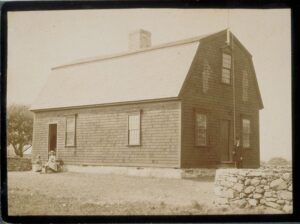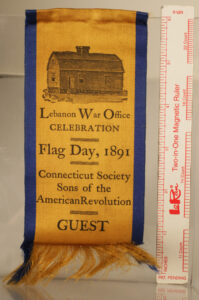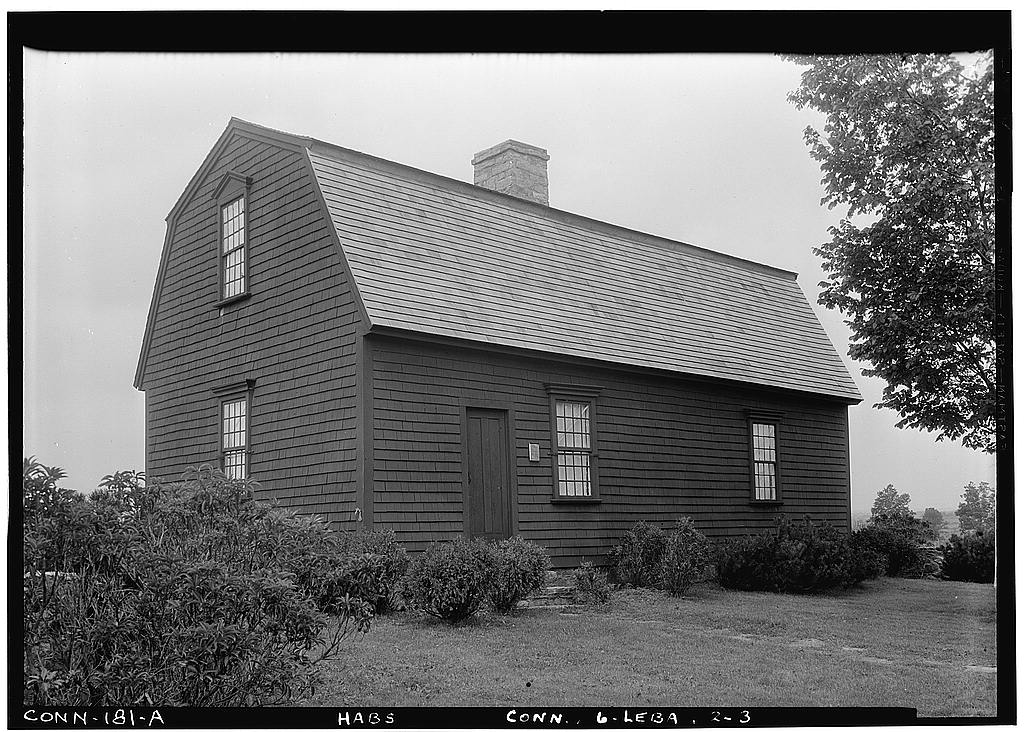By Emily Clark
Considered one of the most important buildings in Connecticut’s Revolutionary War history, Jonathan Trumbull’s War Office in Lebanon functioned as headquarters for Connecticut’s Council of Safety from 1775 to 1783. Decisions out of the War Office worked towards protecting the colony, supporting the patriots, and supplying provisions to the Continental Army.
Governor and Military Strategist

War Office, Lebanon, 1890 – Connecticut Museum of Culture and History. Used through Fair Use and Public Domain.
A former member of the Connecticut General Assembly, Jonathan Trumbull held the position of Deputy Governor before being appointed governor in 1769 (completing the term of William Pitkin after he died in office) and continued to serve until 1784. Due the tumultuous times in the years before and during the American Revolution, Trumbull was the only one of the 13 colonial governors to support the patriot cause. Trumbull worked out of a small building on the Lebanon Town Green.
The War Office—built around 1732 by Trumbull’s father—was originally called the Captain Joseph Trumbull Store. It is a 1½ story gambrel-roofed building with a central brick chimney and clapboarded exterior located facing the Lebanon Town Green close to its original site. It operated primarily as a mercantile and office for the captain’s shipping business until the outbreak of the Revolutionary War. At that time, Jonathan Trumbull, then governor, began using the space for official business and as a meeting place for military leaders and notable visitors to the colony.
A Political Center
In spring of 1775, the Connecticut General Assembly established a sub-committee called the Council of Safety to lend the governor assistance for the war effort when the Assembly itself was not in session. This Council convened over one thousand confidential meetings to plan strategy from the time the war began until the Treaty of Paris in 1783—many held at the Lebanon War Office. Trumbull also met with American and French officers in the tight quarters of this small building. At one point, the War Office was connected by a secret tunnel to Governor Trumbull’s house, where his personal office was located. Couriers delivered messages from Lebanon throughout the colonies and down the East Coast, to Congress and to army headquarters. Some have referred to the office as the “Pentagon of the Revolution.”

Photograph of a guest ribbon printed by the Lebanon War Office in Celebration of Flag Day, 1891 – University of North Texas Libraries Special Collections. Used through Fair Use and Public Domain.
Trumbull’s War Office witnessed both the elaborate plans and spontaneous decisions of the daily operations of the American Revolution. Visitors at these meetings included such military personnel as General George Washington, General Henry Knox, Marquis de Lafayette, and Count de Rochambeau as well as American political leaders Thomas Jefferson, Benjamin Franklin, and John Jay. Furthermore, the French Army’s reinforcements under General Duc de Lauzun spent November 1780 to June 1781 camped nearby on the Lebanon Green before meeting up with their fellow soldiers in preparation for the march to the war’s final battle and the British surrender in Virginia.
Important Supply Line
From this office, Trumbull armed and supplied the Connecticut militia and navy, supervising the key industries of war such as the iron and cannon factory in the town of Salisbury. When General Washington needed provisions for the Continental army, specifically during the intense winter at Valley Forge, Trumbull responded from his modest office far away in eastern Connecticut with significant quantities of food, clothing, shoes, and munitions. This generous outpouring of rations and necessities led Connecticut to be nicknamed “The Provisions State.”
After the war ended, the building which housed Jonathan Trumbull’s War Office functioned once again as a store until it deteriorated and was eventually left vacant. Around 1824, the building was moved a short distance north from its original site. In 1891—coinciding with the growth of colonial revival movements—the War Office was restored to look as it did during the Colonial period. Today, this structure is listed on the National Register of Historic Places and is owned and operated by the Sons of the American Revolution.
Emily Clark is a freelance writer and an English and Journalism teacher at Amity Regional High School in Woodbridge.









